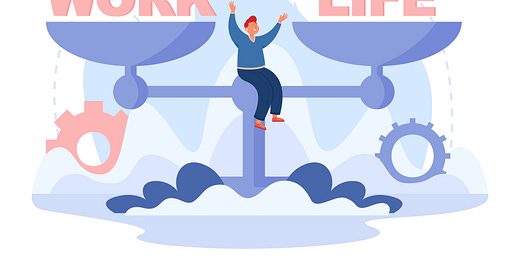CL #8: How Jeff Bezos, Simon Sinek and Gary Keller Find Work-Life Balance
Learn two ways to live a balanced life that blends professional success with personal well-being.
Can we achieve work-life balance?
We all desire to be at a state of balance but often struggle with it:
Too much work and we neglect spending time with our family, or resting.
Too much rest and time with family, and we worry over work and money.
Unfortunately for most of us, work always tips the scale in the work-life balance conversation. I mean, we’ve got to survive, right?
You barely hear someone complaining that they are spending too much time with their kids. Or resting too much.
But you constantly hear people complaining that they don’t have enough time with their families. Or that they are burnt out and need to rest. I mean, people literally faint at work due to lack of rest.
In this article, we will explore two ways in which we can achieve work-life balance.
#1: Work-Life Integration
Before Covid-19, work-life balance could be simply achieved by not carrying your work home.
But things have changed.
Hybrid and remote working environments have erased the boundary between work and life. You can do life and work from anywhere now.
Work-life integration refers to blending your work and life in a way that is natural, instead of treating them as separate entities. It therefore allows for fulfillment in both areas by finding opportunities of compromise and synergy.
Simon Sinek, author of Start with Why explains the concept of work life integration in the 1 minute clip below:
To implement work-life integration effectively, you also need to monitor your energy and switch between tasks that energize you and those that de-energize you.
Jeff Bezos, founder of Amazon.com, and the third richest person in the world takes a minute to explain the concept of work-life harmony to keep you energized both at work and in life:
Managing your energy will increase your capacity to do more and have enough bandwidth for everything you need to accomplish.
Action: Take stock of the tasks that energize you and those that de-energize you. Plan your day accordingly based on those tasks that could fit in work or life.
#2: Work-Life Counterbalance
Popularized by Gary Keller and Jay Papasan, best selling authors of The One Thing, this view suggests that you ditch the idea of a perfect work-life balance.
Work-life balance is a myth because it suggests that one day your ducks will align and you will be able to equally give the same time, energy and attention to your work and life.
They argue that true success happens at the extremes whether it is in the context of work or life.
“The reason we shouldn’t pursue balance is that magic never happens in the middle; magic happens at the extremes.”
But there’s a catch.
“The dilemma is that chasing the extremes presents real challenges. We naturally understand that success lies at the outer edges, but we don’t know how to manage our lives while we’re out there.”
They then warn on the dangers of spending too much time at the extremes:
When we focus deeply on one area, most other parts of our lives will be at a stand-still, ‘hibernating’ until we’re ready to come back to them. But we have to understand that too long spent at the extremes can start actively damaging some areas — particularly when other people are involved.
The solution to this dilemma is the concept of Counter-balance.
Counter-balance is the process of focusing exclusively on the important task at hand, whether it’s work, teaching our kids something or working out. We have to choose what’s critical and give it as much time as it needs before switching to the next most important thing.
Listen to this 2 minutes video breaking down the idea of work-life counterbalance:
The idea focuses on the concept of clear boundaries between work and life/rest. Gary argues that when you truly work when you’re supposed to work, you will have enough time to relax. Just don’t mix the two.
Whatever you’re doing be fully present.
This is the secret of counter-balance: bringing our full attention to the effort at hand.
When you’re working, work hard and when you’re playing, play hard for that is where the impact happens.
Conclusion
Work-life balance does not mean playing ping pong or having free food in the office.
Nigel Marsh, best selling author of four books – Fat, Forty and Fired; Overworked and Underlaid; Fit, Fifty and Fired-Up and Smart, Stupid and Sixty gives a TED Talk on How to make work-life balance work. Here’s a 2 minute clip from his talk:
Some key takeaways from the clip are:
We can’t rely on governments or corporations to solve for our work life balance. We have to take responsibility for our time.
If you don’t design your life, someone else will design your life for you and you won’t like their idea of balance.
Be kind to yourself. Elongate the time in which you judge your work life balance. Remember that you can’t do everything in a day but do this without falling into the trap of, “I’ll have a life when I retire.” If you don’t take care of your family now, you’ll have no one after you retire.
Implementing work life balance does not require a total change of lifestyle. It is about the small things that you do for your family, the regular time that you spend with family and friends.
Whether you’ll follow the approach of work-life integration or work-life counterbalance, take a small step today to balance your life.
That’s it for today! If you enjoyed this post, please support me by taking two actions:





I like the idea of the work-life counter balance as it is more representative of how I desire to pursue an ambitious life.
Thank you for helping me get a name that explains this concept.